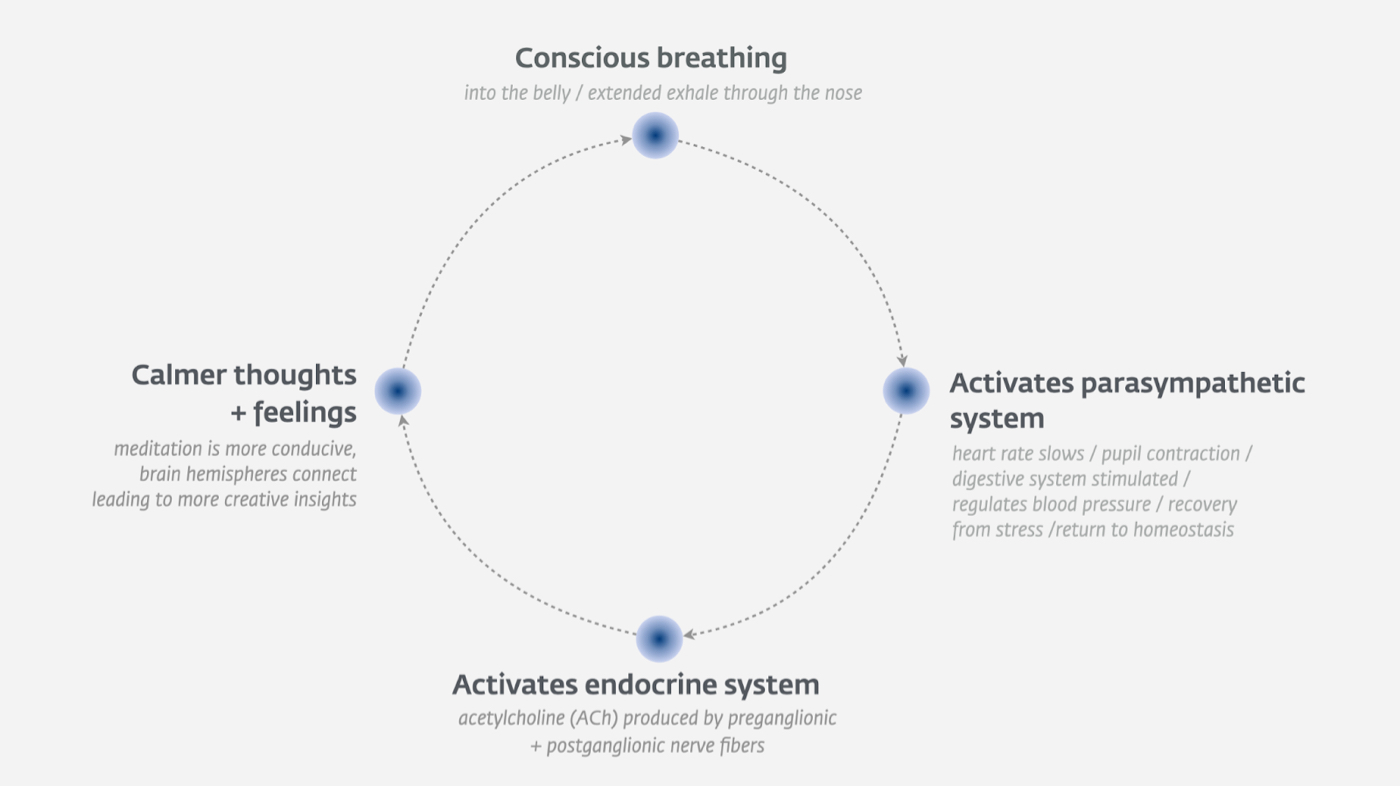
Sponsored By: Future London Academy
This article is brought to you by MBA for Design Leaders at Future London Academy. Learn Business Strategy, Finance, and Leadership from Spotify, Wolff Olins, Monzo, Pentagram, AKQA, and others. Only 30 spots are available.
Techniques for tactical mindfulness—using mind-based or “top-down” tools to influence our thoughts and feelings—have exploded in popularity.
But when our nervous systems are hijacked and adrenaline is coursing through our veins, unless we have thousands of hours of mindfulness training, it can be hard to avoid panic mode, let alone drop into meditation.
Fortunately, it is possible (and, as I will argue, far more efficient) to leverage your physiology—known as “bottom-up” practices—by using breathwork to self-regulate and positively impact your internal state in real-time.
The cultivation of calm
The human nervous system is one of the most technologically advanced operating systems in the known universe. It is not only responsible for our energy levels (aka productivity) and capacity for relaxation, but it is also the filter through which we experience the world and people around us.
You would think this remarkable network of neurological hardware would have a complex instruction manual. Fortunately, it is more simple to learn than you might think.
Many of us find it challenging to think clearly when our nervous system has been hijacked by a trigger or an intense situation. Perhaps you experienced nervous energy, even anxiety, before an important conversation or presentation, which hindered your capacity to give it your best or be fully present. Or maybe you felt lethargy creep in when you sat down for a deep workflow session.
Making matters worse is that unproductive thought loops and feelings exacerbate the issue. These reactive states are the underlying cause of ineffectiveness, reactivity, conflict, and regrettable decision-making.
Luckily, there is a zero-cost solution to this quandary—an always-accessible operating manual for your nervous system that is more effective than any prescription drug, with no unwanted side effects. In fact, it has been under your nose since you were born: your breath.
I’m going to explain the science of how breathwork functions, and then I’ll give you some actionable exercises so that you can do it yourself. Drawing from recent discoveries in neurobiology, there are two concepts that will empower you to be more effective in aligning the state of your nervous system with your desired state of grounded calm or clear focus.
- The nervous system remote: using the bottom-up method of our breath to impact blood chemistry, which shifts the thoughts and feelings that arise
- If [this] then [breathe]: two protocols you can use to effectively leverage your biology to up- or down-regulate your state, accessing either focus or calm as required
Finally, a business program for design leaders.
Future London Academy's MBA for Creative Leaders is an executive program broken down into 5 intense 2‑week modules in London and California.
Forget boring professors and outdated business knowledge. You will be taught by CEOs, CTOs and Heads of Design from the top businesses, startups and products companies.
The nervous system operating manual
How is your breath right now? Take a moment to tune in. There’s a reasonable chance (especially if you are reading this on your phone) that your breath is shallow, in the upper chest and possibly through the mouth.
Our breath is perhaps the only activity in our body that happens on its own that can also be consciously controlled. Yet it is rare for most of us to inquire how our breath is or consciously control it. Why does this matter?
Because how we breathe impacts how we feel, how we show up in the world, and even the types of thoughts that arise. (Tip: As you read the following paragraphs, explore deliberately breathing faster than usual through your mouth and into your upper chest.)
Deep inside your brain lies a piece of biological hardware known as your insula cortex. It interprets signals from your breathing rhythms, serving as a central hub for somatic (bodily) and interoceptive—or internal—signals.
Image credit: BMJ
When you breathe through the mouth and into the upper lungs, signals are relayed to activate the sympathetic or activating part of your nervous system, creating a cascade effect that communicates to your endocrine system to secrete adrenaline and cortisol—which, in turn, generate measurable shifts in your blood chemistry.
These shifts in blood chemistry impact the emotions you feel and even the tone of thoughts that will arise—like impulsive actions, anxious thoughts, and feelings of frustration. We can fall into a trap as these unproductive thoughts and feelings reinforce or even exacerbate the breath pattern that activates the sympathetic response in the nervous system.
(If you haven’t already, you can let your breathing return to normal. Notice how you feel internally.)
Here, the common strategy is to attempt to think our way out of the stress. You may be familiar with tactical mindfulness, cognitive reframes, or thoughts of loving-kindness to change your state of mind. These act as top-down interventions for throwing a wrench into the negative thought spiral. However, it’s possible—and more effective—to shift your breathing pattern to generate calmer thoughts and feelings.
There are important neurological reasons why. Our nervous system consists of 80% of afferent neurons, which move from the body to the brain—in contrast to roughly 20% of efferent neurons, which run in the opposite direction, from the brain to the body.
As a result, so-called bottom-up interventions—or practices that leverage our physiology by consciously shifting our respiratory or visual systems—are 4x more effective at altering our blood chemistry and, therefore, shifting our state.
Embrace state over story
Working with clients, I will often talk about “state before story”—the idea that the stories we tell ourselves and the perspectives we inhabit are a function of our nervous system state.
If our system is overwhelmed or dysregulated, the mind will find reasons to explain why. At times, we might even invent false reasons to justify the internal anxious state.
By intervening at the level of our biology, leveraging our physiology to shift blood chemistry and regulate the nervous system, new stories arise, and in many cases, the insurmountable challenges seem to solve themselves.
Once this idea clicks, the impact is profound. The CEO of a rocket ship company told me that he now felt able to “regulate [his] energy through the ups and downs of running a startup.” A senior product manager at Amazon similarly shared, “I have lost the fear of stress activation since I can now interpret it and also regulate it.”
If we deliberately change the way that we breathe, for example, using exhales that are twice the length of the inhale, we consciously send different signals to the medulla oblongata (the brain’s control center), just as we might change the input channel on a television remote. This part of our brain responds with instructions to the endocrine system to produce a neurotransmitter that slows down our heart rate, regulates blood pressure, and returns our body to homeostasis.
It’s a profound insight from the neuroscience literature—that our seemingly objective experience of reality is, in fact, entirely mediated through neurotransmitters. Furthermore, because shifts in breathing patterns create reliable and consistent shifts in blood chemistry, we can learn how to alter our moment-to-moment lived experiences.
No matter how intense an external situation might be, whether it’s dealing with screaming children or a boardroom confrontation, there is always a grounded center of calm available to you through consciously shifting your breathing rhythm.
Now that we’ve talked about the science of how this works, I’ll walk you through the exercises to put it into practice.
If [this] then [breathe]
You’ve probably come across iPhone shortcuts or automation tools that allow you to write something along the lines of: If [tweet] then [save to Evernote] or If [time = 7 p.m.] then [dim lights].
Here are two automation recipes you can use to up or down-regulate—i.e., activate or calm—your nervous system in real-time. These exercises take advantage of the changes in blood chemistry shared above.
- If [lethargic or sleepy] then [espresso breath]
- If [anxious or overwhelmed] then [breath of calm]
Let’s start with espresso breath.
Espresso breath
Sit up with a straight lower spine, tuck your chin slightly, and begin rapid exhales through your nose, at the rate of roughly two per second. The inhale happens naturally. You should feel your belly contracting like a pump with each exhale. Continue for 30 exhales. Once you’ve completed this, exhale completely to the end of your breath, holding until you feel mild breath-hunger (the desire to inhale).
Then inhale deeply and hold at the top for 20-30 seconds. Release the breath completely, keeping your body as motionless as possible for 30 seconds afterward to allow the effects to settle.
Repeat this 2-3 times as desired. You may also experiment with noticing how this short practice creates a shift in your internal state.
The author practicing "breath of calm."(Credit: Kelly Miller)Breath of calm
This practice uses the technique of alternate nostril breathing that has been shown in studies to effectively reduce anxiety, combined with an exhale that is twice the length of the inhale. Longer exhales are key for the down-regulation of the parasympathetic nervous system, which is the branch that enables us to recover and rejuvenate following a stressor and also creates the conditions for sleep in the evening.
Ensure you’re sitting comfortably, ideally with a straight lower spine. Bring your right hand up to your face, using your ring finger to close the left nostril and your thumb to close the right nostril.
Begin by closing the right nostril and inhaling through the left side for a count of three. Then hold at the top for three. Exhale through the right side for a count of six. Now inhale right-side for three, hold for three, and exhale left for six. This is one full round. If you find a count of three and six challenging, start with inhaling for two, holding two, and exhaling for four. Over time your carbon dioxide tolerance will increase, and you can extend to counts of 10 in and 20 out.
Repeat for 3-5 rounds or until you feel sufficiently calm. It’s beneficial to end the practice with a full inhale and an audible relaxed sigh, which deepens the relaxation response.
There are various cues to watch for to see if your body is downshifting gears into parasympathetic. The most obvious is a spontaneous sigh response, but you also may be aware of a softening in muscular tension in the shoulders and belly or a more relaxed gaze.
Flipping your internal switch
In my experience, breathwork practices are the most efficient protocols for shifting my state in real-time. I’ve seen first-hand how these zero-cost tools have empowered clients to navigate intensely stressful situations—from calming pre-interview nerves to stepping into the public speaking arena with far greater conviction and composure.
The next time you notice a negative thought loop arises or sense the tentacles of overwhelm take hold, remember “state over story”: Find a quiet place where you can practice for two minutes, give this breath of calm a try, and notice what a radical difference it makes.
Jonny Miller hosts the Curious Humans podcast and Nervous System Mastery, an upcoming cohort-based boot camp that shares evidence-based protocols for cultivating calm and resilience. Learn more.
Gratitude to Kate Lee, Dan Shipper, Stephanie Freed, Colin Brauns, Alison Zamora, and Valeria Zhang for providing feedback.
Ideas and Apps to
Thrive in the AI Age
The essential toolkit for those shaping the future
"This might be the best value you
can get from an AI subscription."
- Jay S.
Join 100,000+ leaders, builders, and innovators

Email address
Already have an account? Sign in
What is included in a subscription?
Daily insights from AI pioneers + early access to powerful AI tools
Sparkle: Organize your Mac with AI
Cora: The most human way to do email
Spiral: Repurpose your content endlessly








Comments
Don't have an account? Sign up!
kudos to buda.
Great article. Excellent in theory. Very insightful on a lot of levels. Just missing a tad more practice, to make this more actionable in exactly the situations you describe - screaming children, boardroom confrontations... Tough to do alternate nostril breathing in those situations 😉 That said, I gained two important insights. I think I've understood how Novak Djokovic is so calm as I noticed he does intentional nostril breathing when he is winded or if a match situation is stressful. Also that simply nostril breathing, with an exhale twice at long as there inhale can help calm the system... Thanks for these insights!